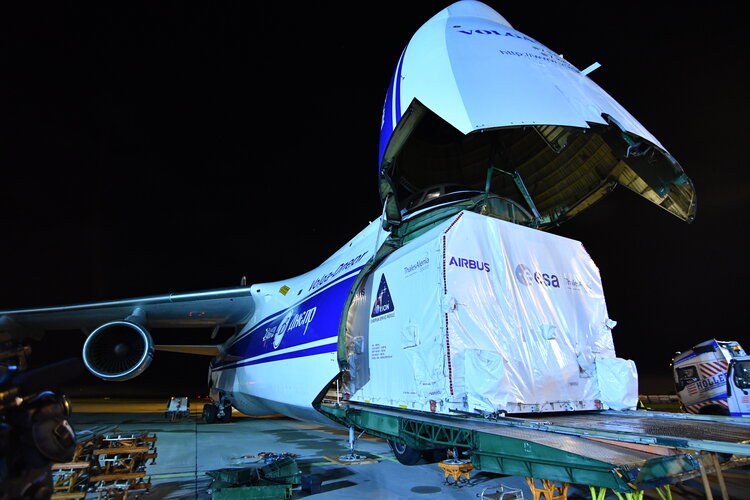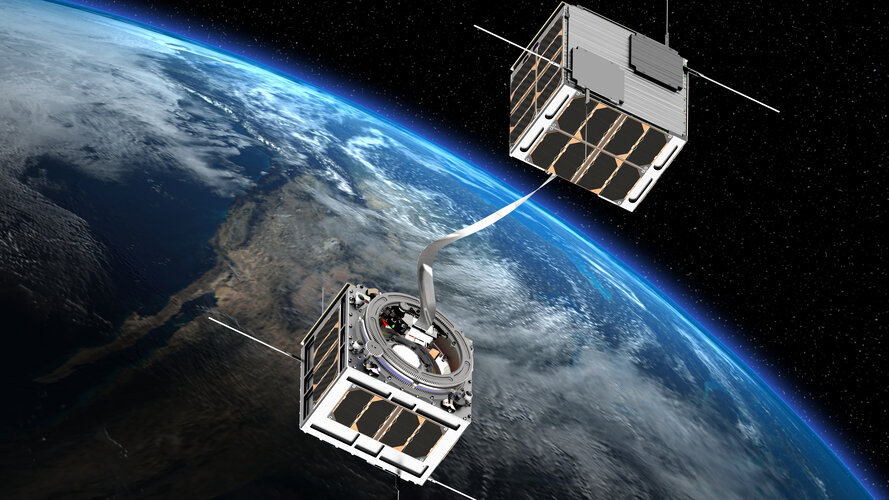
Copernical Team
Europe delivers module for first astronaut mission to the Moon

The second European Service Module for NASA’s Orion spacecraft is on its way to USA. It is the last stopover on Earth before this made-in-Europe powerhouse takes the first astronauts around the Moon on the Artemis II mission.
To oldly go: Shatner, 90, inspires with real-life space trip

As William Shatner prepares to be beamed up Wednesday for his first real-life spaceflight, and to become at 90 the oldest person ever to enter the final frontier, he's bringing out the awe in the small handful of people around a rural Texas spaceport.
Tethered satellites for propulsion without fuel
 Image:
Tethered satellites for propulsion without fuel
Image:
Tethered satellites for propulsion without fuel ESO images some of the biggest asteroids in our Solar System

With first Martian samples packed, Perseverance initiates remarkable sample return mission

NASA, along with the European Space Agency, is developing a campaign to return the Martian samples to Earth.
On Sept. 1, NASA's Perseverance rover unfurled its arm, placed a drill bit at the Martian surface, and drilled about 2 inches, or 6 centimeters, down to extract a rock core. The rover later sealed the rock core in its tube. This historic event marked the first time a spacecraft packed up a rock sample from another planet that could be returned to Earth by future spacecraft.
Mars Sample Return is a multi-mission campaign designed to retrieve the cores Perseverance will collect over the next several years.
NASA's Webb space telescope arrives in French Guiana after sea voyage

NASA's James Webb Space Telescope successfully arrived in French Guiana Tuesday, after a 16-day journey at sea. The 1,500-mile voyage took Webb from California through the Panama Canal to Port de Pariacabo on the Kourou River in French Guiana, on the northeastern coast of South America.
The world's largest and most complex space science observatory will now be driven to its launch site, Europe's Spaceport in Kourou, where it will begin two months of operational preparations before its launch on an Ariane 5 rocket, scheduled for Dec. 18.
Once operational, Webb will reveal insights about all phases of cosmic history—back to just after the big bang—and will help search for signs of potential habitability among the thousands of exoplanets scientists have discovered in recent years.
Planet announces plans for new fleet of Earth observation satellites

Satellite data provider Planet announced Tuesday that it plans to launch a new fleet of orbiting eyes so powerful they can distinguish road markings on the ground.
Planet, which already operates 200 Earth observation satellites from space, wants to make the new function available in 2023.
The new satellites, called Pelican, could be used for mapping services, such as Google maps; in environmental tasks, such as spotting illegal forest clearers or observing crops; and in defense to monitor troop movements and airport activity.
"The data is faster, it's higher resolution, it's lower latency, it's more on demand," Robbie Schingler, a former NASA engineer who co-founded Planet in 2010, told AFP. "It's a whole new satellite."
The announcement, made at the company's annual conference, underlines the dynamism of the booming nanosatellite market.
Celebrate Virtual International Observe the Moon Night with NASA
 The public is invited to participate in several of NASA’s virtual activities in celebration of International Observe the Moon Night on Saturday, Oct. 16.
The public is invited to participate in several of NASA’s virtual activities in celebration of International Observe the Moon Night on Saturday, Oct. 16. Space exploration should aim for peace, collaboration and co-operation, not war and competition

When the Soviet Union launched Sputnik 1 in 1957, it represented humanity's first significant foray into the cosmos. Our imagination was opened to the wonder and lure of space for human endeavor as science fiction suddenly became science fact.
A space arms race?
At the time, the prevailing Cold War mentality contributed to suspicion and fear about what it meant to be in space, and resulted in the military roots of space technology and applications. John F. Kennedy famously stated that "if the Soviets control space they can control the earth, as in past centuries the nation that controlled the seas dominated the continents."
The Space Race, as it would become known, was characterized by fierce competition between the Soviet Union and the United States to achieve space superiority.
Brain injury after long-duration spaceflight

Spending long periods in space not only leads to muscle atrophy and reductions in bone density, it also seems to have lasting effects on the brain. Neuroimaging studies (amongst others from this LMU team of researchers) has hinted at this over the last three years. However, little is known if the observed brain-structural alterations are harmless or clinically relevant. LMU physicians Professor Peter zu Eulenburg and Professor Alexander Choukér together with renowned researchers from the University of Gothenburg (Sweden) and Russian colleagues have assessed the structural integrity of the human brain via blood-based markers in astronauts after return from a long-duration mission. The researchers could demonstrate with their pilot study published in JAMA Neurology that there are strong indications for brain injury and accelerated aging following a long-duration mission.

